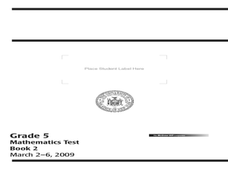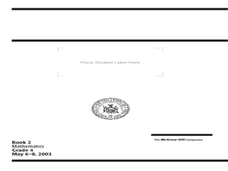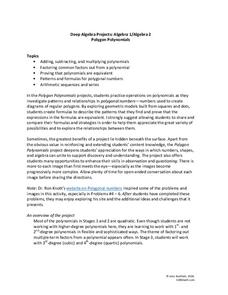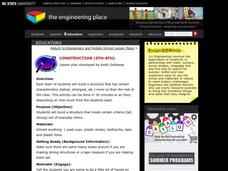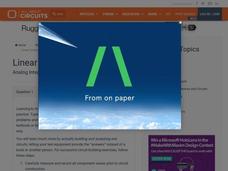Curated OER
New York State Testing Program: Mathematics Book 2, Grade 5 2009
For this 5th grade math standardized test practice worksheet, students solve 8 multiple-step open-ended math problems based on New York academic standards.
Curated OER
New York State Testing Program: Mathematics Book 2, Grade 5 2008
In this 5th grade math standardized test practice worksheet, students solve 7 multiple-step open-ended math problems based on New York academic standards.
Curated OER
New York State Testing Program: Mathematics Book 2, Grade 4 2003
For this 4th grade math standardized test practice worksheet, students solve 48 multiple-step open-ended math problems based on New York academic standards.
Curated OER
Open-Ended; Joining (Addition), Part-Part-Whole
Given a budget, a list of items to put in a treat bag, and how much each item costs might be a little difficult for your students at first. However, these are all going into a treat bag for Madeline's friends. What would your learners...
Curated OER
New York State Testing Program: Mathematics Book 2, Grade 3
In this 3rd grade math standardized test practice worksheet, 3rd graders solve 6 multiple-step open-ended math problems based on New York academic standards.
Curated OER
New York State Testing Program: Mathematics Book 3, Grade 4
In this 4th grade math standardized test practice worksheet, students solve 6 multiple-step open-ended math problems based on New York academic standards.
Curated OER
New York State Testing Program: Mathematics Book 2, Grade 5
In this 5th grade math standardized test practice worksheet, students solve 7 multiple-step open-ended math problems based on New York academic standards.
Curated OER
Finding Mass
Student measure mass to discover how pennies have changed in their composition. In this measurement lesson, 8th graders investigate through an open-ended problem to discover how the US pennies composition changed in the 1980's.
Balanced Assessment
Initials
Learners explore the meaning of groups formed through permutations and combinations with an activity that asks individuals to determine the total number of pupils needed to guarantee that at least one pair has the same initials....
EngageNY
Average Rate of Change
Learners consider the rate of filling a cone in the 23rd installment of this instructional activity series. They analyze the volume of the cone at various heights and discover the rate of filling is not constant. The instructional...
California Education Partners
Least and Greatest
Squares can be magic. Pupils use their knowledge of addition of positive and negative rational numbers to create a 3 X 3 magic square where the sums are 1. Scholars create addition and multiplication expressions with a set of rational...
Achieve
Corn and Oats
How much land does a parcel hold? How much fertilizer does it take for a field of corn? Pupils answer these questions and more as they apply ratio reasoning and unit analysis.
5280 Math
Polygon Polynomials
Patterns in polygons lead to patterns in polynomials. Presented with a series of polygons, individuals create polynomial expressions to represent their patterns. The algebra project consists of nine problems that incorporate polynomial...
North Carolina State University
Construction
Engineering design projects serve as great opportunities for collaborative problem solving. For this case, students work in small groups designing, building, and eventually testing a structure that meets a teacher-specified objective. It...
Balanced Assessment
Red Dots, Blue Dots
Count the connections between dots. Young mathematicians come up with a method to determine the number of connections between pairs of dots. The assessment leads the class to determine the connections they can make when groups are...
5280 Math
Multiplication Table Algebra
Patterns, patterns, everywhere! Young scholars examine the multiplication table to identify patterns. Their exploration leads to an understanding of the difference of squares and sum of cubes by the completion of the algebra project.
Fredonia State University of New York
Watch Your Step…You May Collide!
Can two lines intersect at more than one point? Using yarn, create two lines on the floor of the classroom to find out. Cooperative groups work through the process of solving systems of equations using task cards and three different...
Curated OER
Special Diodes
In this electrical circuit worksheet, students draw a schematic design and build a circuit board to grasp the understanding of diodes. Students answer a series of 8 open-ended questions. This worksheet is printable and there are on-line...
Curated OER
Class B BJT Amplifiers
In this electrical circuit worksheet, students draw a schematic design and build a transmitter to grasp the understanding of bipolar junction transmitters before answering a series of 12 open-ended questions by analyzing schematic...
Curated OER
Bipolar Junction Transistor Theory
In this electrical worksheet, students draw a schematic design and build a bipolar transistor to grasp the understanding of bipolar junction transistor theory before answering a series of 28 open-ended questions. Students analyze...
Curated OER
Millman's Theorem
In this electrical circuit lesson, students will answer 9 open ended questions to mathematically analyze circuits for current and voltage. This online worksheet provides diagrams for better understanding and reveals the answers.
Curated OER
Resonance
For this electrical worksheet, students draw a schematic design and build a circuit board capable of producing a wide range of audio-frequency AC signals before answering a series of 26 open-ended questions. This worksheet is printable...
Curated OER
Linear Computational Circuitry
For this electrical worksheet, students draw a schematic design circuit board to grasp the understanding amplification in linear circuitry before answering a series of 35 open-ended questions pertaining to a variety of linear circuitry....
Curated OER
Transformations
Learners identify the types of transformations in their lives. As a class, they determine the ones they have control over and which ones they do not. They practice solving problems in math and oral communication that they are faced with...
